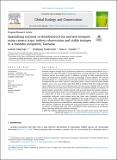| dc.description.abstract | Nutrient hotspots strongly attract mammalian herbivores in nutrient-poor habitats such as
savanna systems. However, little is known about their seasonal importance for mammalian
herbivore species, particularly grazers. In addition, no study has fully quantified the potential re-distribution of nutrients into the surroundings of these hotspots. We assessed
nutrient hotspot (i.e., grazing lawns and termite mounds) use by herbivores in a Miombo
ecosystem of the Issa valley, Tanzania, using dung counts, camera traps and stable isotope
analyses over a one year period, from May 2016 to October 2017. We conducted dung
counts along four transects each radiating away from ten termite mounds and six grazing
lawns as well as in 16 control sites 100 m away from each nutrient hotspot. In addition, we
sprayed grasses around five termite mounds with urea and traced the isotopic signature
back in grazing herbivore dung. Grazer dung deposition was twice as high in hotspot areas
vs control sites. A total of 32 camera stations recorded 244 wildlife encounters, with
mammalian herbivores using hotspot areas four times more frequently compared to
control plots. Stable isotope analyses highlighted that dung deposited by mammalian
grazers around hotspots likely originated from grasses within or close to hotspot areas,
indicating that grazers are responsible for maintaining nutrient stability of these hotspots.
We, therefore, emphasize the importance of grazing mammal species for the long-term
persistence of hotspots and, thus, their contribution to the maintenance of a heterogeneous landscape within the Miombo ecosystem. | en_US |

